Big Eddy
For over 13,000 years, beautifully crafted stone spear points and other artifacts have lain along the Sac River in Cedar County exactly where ancient Indians left them, frozen in place by the accumulation of over 13 feet of river sediment. But beginning in the 1970s, the river that protected the site began destroying it. The bank began eroding sideways, gradually destroying what archaeologists named the Big Eddy site, a unique window into Missouri's, and the nation's, past.
Recognizing that much of the erosion was due to large volumes of water released from the nearby Stockton Dam for power generation, the Kansas City District of the U.S. Army Corps of Engineers funded five seasons of archaeological excavations at Big Eddy between 1997 and 2005. When archaeologists from the Center for Archaeological Research (CAR) at Missouri State University in Springfield began their work in 1997, they only knew for certain that it contained evidence of Indian occupation dating back about 8,000 years. But as work progressed, they discovered artifacts that are among the oldest ever found on the continent, finds made even more important because they have been little disturbed since their deposition as much as 13,000 or more years ago.
Many groups of prehistoric Indians chose the Big Eddy site as a place to camp over thousands of years. The adjacent Sac River would have provided foods such as fish, mussels, water fowl, and edible aquatic and semi-aquatic plants, while the surrounding forests and prairies contained other useful terrestrial plants and various animals such as deer and turkey. Stone was another critical resource; several different kinds of chert, the flint-like rock used to make stone tools, was readily available in the gravel bars of the Sac River and along the bluff slopes near the site.
Archaeologists divide prehistoric time into a series of periods based on general changes in how Indians lived, such as the invention of pottery or the use of agriculture. Within each period, there are numerous subperiods, cultures, and traditions based on common features such as tool types or pottery decoration. At Big Eddy, every major period is represented in the river terrace, with the more recent material near the top and the oldest artifacts 11 to 13 feet deep.
While all the remains at the site are important for understanding various aspects of prehistoric Indian life, some of the oldest deposits at Big Eddy, which date to the Paleoindian period (about 11,500 to 13,500 years old), are what make the site critically important. Paleoindian peoples traditionally have been considered the first documented inhabitants of the Americas. The ancestors of American Indians perhaps entered North America from Asia sometime around 15,000 years ago, during the last Ice Age. For several millennia, they left behind only limited, scattered traces of their existence. During the Paleoindian period, there is evidence of small nomadic bands having spread throughout most of the Americas.
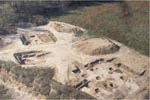
Aerial view of Big Eddy
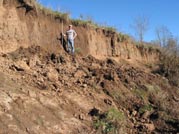
Bank slumpage at Big Eddy

At least three (and perhaps as many as five) Paleoindian cultures are definitely represented at Big Eddy, each characterized by distinctive types of spear points: Clovis (or to some, Gainey), Dalton, and San Patrice. Archaeologists believe Clovis existed from about 12,500 to 13,500 years ago and Dalton from about 11,500 to less than 12,500 years ago. Though carbon-14 dates for these cultures are rare, 15 dates have been obtained from Paleoindian deposits at Big Eddy.
Big Eddy is of fundamental importance to understanding the early occupation of the Midwest. Paleoindian sites that yield substantial data on how these people lived are very rare. Spear points from the period are well known throughout the Midwest and other regions. Most often they are found as isolated artifacts on ridge tops or at sites with artifacts from many periods mixed together. While Big Eddy was used by Indians over thousands of years, the gradual build up of terrace deposits at the site left artifacts from the different periods vertically separated. In archaeological jargon, it is a well-stratified site. Such sites are common in some river valleys, but few have produced remains as old as those at Big Eddy.
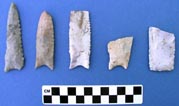
Daton points from Big Eddy
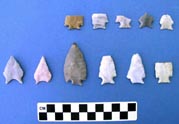
San Patrice points from Big Eddy
This stratification has provided nearly unprecedented data on the Clovis, Dalton, and San Patrice cultures. Archaeology is far more than documenting spear points and other eye-catching artifacts; it tries to use the full range of material left by past peoples to understand their environment and how they lived. While styles of spear points tend to change over time, many other tools do not. The manufacture of stone tools also produces many waste flakes, bits of stone that were abandoned or discarded as cobbles or large flakes were shaped into tools. These waste flakes can be important clues about how tools were manufactured and where the stone was obtained. In a stratified site all the material associated with a particular culture can be studied separately from the material remains of older and younger cultures.
The sealed strata also allow analysis of where particular activities were conducted across the site. Most of the artifacts and waste flakes are still resting where they were left thousands of years ago. In the Dalton and San Patrice stratum, archaeologists have uncovered dozens of areas where stone tools were manufactured and other activities were conducted. These materials have greatly increased our knowledge of each occupation's spatial organization.
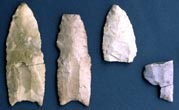
Clovis points from Big Eddy
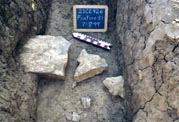
Possible pre-Clovis anvilstone
The presence of both Clovis and Dalton-San Patrice strata offers a unique opportunity to study the relationship between these cultures. Clovis peoples lived in an environment much different from that of today. Glaciers still covered large areas of North America, although they were melting rapidly at about this time. Ice Age animals such as mastodons and mammoths roamed the plains and forests—and were hunted by the Clovis people. By Dalton–San Patrice times these animals were extinct.
An even more exciting prospect is the possibility that at least one occupation level predating the Clovis culture is present at the Big Eddy site. Tantalizing yet inconclusive evidence of human occupation dating to 14,000 to 15,000 years ago was found in 1999, 2002, and 2005.
The importance of the Big Eddy site has already been widely recognized by archaeologists across the country, many of whom have visited the site at one or more times during the four field seasons:
- "The Big Eddy site has the potential of being one of the most important stratified Paleoindian sites in the country." --Dr. Dennis Stanford, Department of Anthropology, Smithsonian Institution
- "This is the first discovery of such a significant multicomponent Paleoindian site in a stratified alluvial context. As such it is a major archaeological discovery." --Dr. C. Vance Haynes, Regents Professor, University of Arizona
- "[Big Eddy] truly may be one of the archaeological 'treasures' of the midcontinent." --Dr. R. Bruce McMillan, Director Emeritus, Illinois State Museum
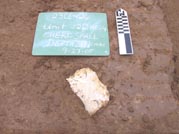
Possible pre-Clovis large flake